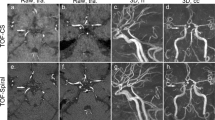Summary
This study was designed to assess the diagnostic value of 3D time-of-flight MR-angiography in cerebral cavernomas. In seven patients, nine out of ten cavernomas were removed by microsurgery. While MR-angiography demonstrated well branches of brain arteries adjacent to the lesions, no flow signal in the vascular malformations was observed. On the other hand, there was a high intensity signal induced by methaemoglobin in those three patients with brainstem cavernomas who had experienced a significant bleeding attack seven months prior to admission. It had a spotted appearence in MR-angiography with volumes of the largest spots around 1.8 cm3. It is suggested that this spot signal could be used as a path marker for the surgical approach in brainstem cavernomas.
Similar content being viewed by others
Abbreviations
- FISP:
-
Fast Imaging with Steady Precision
- FLASH:
-
Fast Low Angle Shot
- MIP:
-
Maximum Intensity Projection Method
- MRI:
-
Magnetic Resonance Imaging
- MRA:
-
Magnetic Resonance Angiography
- SE:
-
Spin Echo Sequence
- 3D:
-
Three dimensional
References
Atlas WS, Mark AS, Fram EK, Grossman RI (1988) Vascular intracranial lesions: Applications of gradient-echo MR imaging. Radiology 169: 455–461
Biondi A, Scialfa G (1988) Morphological and blood flow MR findings in cerebral vascular malformations. J Neuroradiol 15: 253–265
Cohen HCM, Tucker WS, Humphreys RP, Perrin RJ (1982) Angiographically cryptic histologically verified cerebrovascular malformations. Neurosurgery 10: 704–714
Edelman RR, Mattle HP, Atkinson DJ, Hoogewoud HM (1990) MR angiography. AJR 154: 937–946
Fahlbusch R, Strauss C, Huk W, Röckelein G, Kömpf D, Ruprecht KW (1990) Surgical removal of pontomesencephalic cavernous hemangiomas. Neurosurgery 26: 449–457
Giombini S, Morello G (1978) Cavernous angiomas of the brain. Account of fourteen personal cases and review of the literature. Acta Neurochir (Wien) 40: 61–82
Gomori JM, Grossman RI, Goldberg HI, Hackney DB, Zimmerman RA, Bilaniuk LT (1986) Occult cerebral vascular malformations: high-field imaging. Radiology 158: 707–713
Graf CJ, Perret GE, Torner JC (1983) Bleeding from cerebral arterio-venous malformations as part of their natural history. JNeurosurg 58: 331–337
Griffin C, DeLaPaz R, Enzman D (1987) Magnetic resonance appearance of slow flow vascular malformations of the brainstem. Neuroradiology 29: 506–511
Harder T, Dewes W, Solymosi L, Steudel A, Brassel F (1989) MR-Tomographie, CT und Angiographie vaskulärer Malformationen des zentralen Nervensystems. Fortschr Röntgenstr 150(2): 119–114
Kashiwagi S, Van Loveren HR, Tew JM, Wiot JG, Weil SM, Lukin RA (1990) Diagnosis and treatment of vascular brainstem malformations. J Neurosurg 72: 27–34
Laub GA, Kaiser WA (1988) MR angiography with gradient motion refocusing. J Comput Assist Tomogr 12(3): 377–38
Lemme-Plaghos L, Kucharczyk W, Brant-Zawadzki M, Uske A, Edwards M, Norman D, Newton TH (1986) MRI of angiographically occult vascular malformations. AJR 146: 1223–1228
Lobato RD, Perez C, Rivas JJ, Cordobes F (1988) Clinical, radiological, and pathological spectrum of angiographically occult intracranial vascular malformations. Analysis of 21 cases and review of the literature. J Neurosurg 68: 518–531
Marchal G, Bosmans H, Van Fraeyenhoven L, Wilms G, Van Hecke P, Plets C, Baert AL (1990) Intracranial vascular lesions: Optimization and clinical evaluation of three-dimensional time-of-flight MR angiography. Radiology 175: 443–448
Martin NA, Wilson CB, Stein BM (1984) Venous and cavernous malformations. In: Wilson CB, Stein BM (eds) Intracranial arteriovenous malformations. Williams & Wilkins, Baltimore London, pp 234–245
Ogilvy CS, Heros RC, Ojemann RG, New PF (1988) Angiographically occult arteriovenous malformations. J Neurosurg 69: 350–355
Ondra SL, Troupp H, George ED, Schwab K (1990) The natural history of symptomatic arteriovenous malformations of the brain: a 24-year follow-up assessment. J Neurosurg 73: 387–391
Rigamonti D, Drayer BP, Johnson PC, Hadley MN, Zabramski J, Spetzler RF (1987) The MRI appearance of cavernous malformations (angiomas). J Neurosurg 67: 518–524
Rigamonti D, Hadley MN, Drayer BP, Johnson PC, Hoenig-Rigamonti K, Knight JT, Spetzler RF (1988) Cerebral cavernous malformations. Incidence and familial occurrence. N Engl J Med 319: 343–347
Robinson JR, Little JR, Awad IA (1990) The natural history of cavernous angiomas. J Neurosurg 72: 333A
Simard JM, Garcia-Bengochea F, Ballinger WE, Mickle JP, Quisling RG (1986) Cavernous angioma: A review of 126 collected and 12 new clinical cases. Neurosurgery 18: 162–172
Stein BM, Mohr JP (1988) Vascular malformations of the brain. New Engl J Med 319: 368–369 [letter]
Voigt K, Yasargil MG (1976) Cerebral cavernous haemangiomas or cavernomas. Neurochirurgia (Stuttgart) 19: 59–68
Weil S, Tew JM, Steiner L (1990) Comparison of radiosurgery and microsurgery for treatment of cavernous malformations of the brain stem. J Neurosurg 72: 336A
Yaşargil MG, Microneurosurgery, Vol IIIb. Georg Thieme, Stuttgart New York, p 20
Author information
Authors and Affiliations
Rights and permissions
About this article
Cite this article
Wowra, B., Layer, G., Schad, L.R. et al. Three-dimensional time-of-flight MR-angiography and the surgical indication in brainstem cavernomas. Acta neurochir 112, 77–82 (1991). https://doi.org/10.1007/BF01405130
Issue Date:
DOI: https://doi.org/10.1007/BF01405130




